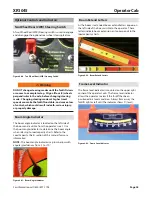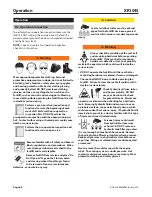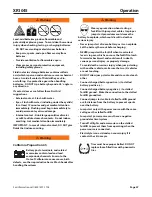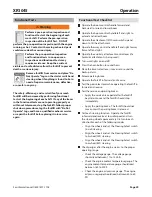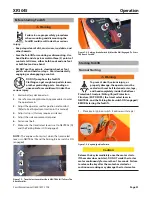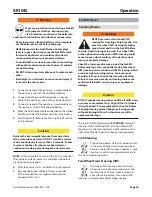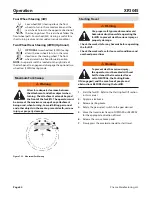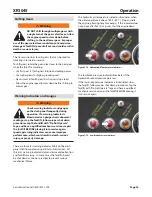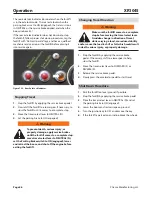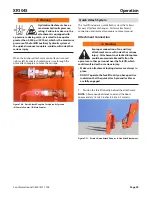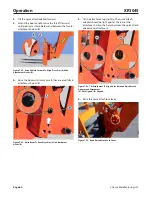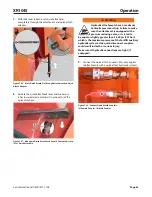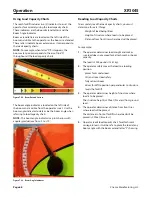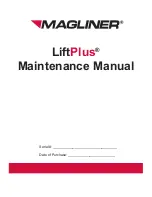
For information call (800) 497-1704
Page 53
XR1045
Operation
Warning
Wear eye protection when starting a forklift
with jump start cables. Improper jump
start procedures could cause the battery to
explode, which could result in death or serious injury.
• Never jump start a frozen battery, as it can explode.
Let the battery thaw out before charging.
• NEVER jump start the forklift when travel select
lever is in gear, which can cause the forklift to lurch
forward or backward, and could result in death,
serious personal injury, or property damage.
• To avoid death or serious injury when jump starting
with another vehicle, make sure the two (2) vehicles
are not touching.
• DO NOT allow jump start cable ends to contact each
other.
• Electrolyte is an acid and can cause serious injury if
it contacts the skin or eyes.
1.
Connect one end of the positive (+) jumper cable to
the positive (+) post of the discharged battery
2.
Connect the other end of the positive (+) jumper
cable to the positive (+) post of the charged battery
3.
Connect one end of the negative (-) jumper cable to
the negative (-) post of the charged battery
4.
Make the final jumper cable connection to the stalled
forklift ground at the furthest point from the battery
5.
Start the forklift Refer to the Starting Forklift section
in this manual
Caution
Release the key immediately once the motor starts.
If the motor does not start, DO NOT crank the starter
motor continuously for more than 15 seconds. Failure
to release the key after the motor has started or
continuous cranking may damage the starter motor.
NOTE:
If the engine fails to start on the first try, wait until
the engine and starter come to a complete stop before
cranking the engine again
6.
After the engine starts, let idle for 30 to 60 seconds
7.
Remove the jumper cables in the reverse order
of their connection (i e negative cable ground
connection first, etc )
Forklift Travel
Steering Modes
Warning
NEVER use crab or four wheel (4W)
steering for traveling at high speeds. Use
only two wheel (2W) steering for higher
speed travel and slow the forklift before
turning. Rapid turning using crab, four wheel (4W),
or the optional two wheel rear (2WR) steering could
cause tip over, which could result in death, serious
injury, or property damage.
Check the turning radius area around the forklift
before making a turn, especially if using four wheel
(4W) steering or two wheel rear (2WR) steering, which
provide a tighter turning radius. Look over your
shoulder in the direction of the turn when backing.
Failure to remain aware of your turning radius area
could result in death, serious injury, or equipment
damage.
Caution
DO NOT change steering modes until the forklift slows
or comes to a complete stop. Align all four (4) wheels
“straight-ahead”, or perpendicular to the axle, before
changing steering mode. Changing steering modes
without aligning all four (4) wheels may result in
equipment damage.
The reach forklift includes three
STANDARD
modes of
steering; Crab, Two Wheel (2W), and Four Wheel (4W)
Steering Use the Steering Select switch located on the
right side of the dash panel to change steering modes
Crab Steering
Crab steering allows all four (4) wheels to turn
in the same direction as the steering wheel,
allowing the forklift to move “sideways” Crab
steering is useful in a congested work site to
line up to a loading location
Two Wheel Front Steering (2W)
Two wheel (2W) steering allows the front
wheels to turn in the same direction as the
steering wheel The rear wheels remain in
a fixed forward position Two wheel (2W)
steering is useful for traveling at higher speeds







